HR6004 - Netflix's Strategies for Thriving Against Amazon Prime
VerifiedAdded on 2023/04/23
|26
|7046
|375
Report
AI Summary
This research report explores the strategies employed by Netflix to maintain its dominance in the subscription-based online video-on-demand service market, particularly in the face of increasing competition from Amazon Prime. It examines the business strategies of both companies, their customer segmentation systems, and their market positions. Netflix, initially benefiting from its first-mover advantage, has focused on internationalization, localization, content diversification through original productions, and digital marketing. Amazon Prime, leveraging its established e-commerce platform, utilizes a cost leadership strategy, offering bundled services at competitive prices. The report also addresses the challenges both companies face, such as content licensing issues, and provides recommendations for Netflix to enhance its market share. Desklib offers similar solved assignments and past papers for students.

Running head: BUSINESS MANAGEMENT
The efficiency of strategies Netflix put in place to survive the turbulence by Amazon Prime
Name of the Student:
Name of the University:
Author note:
The efficiency of strategies Netflix put in place to survive the turbulence by Amazon Prime
Name of the Student:
Name of the University:
Author note:
Paraphrase This Document
Need a fresh take? Get an instant paraphrase of this document with our AI Paraphraser
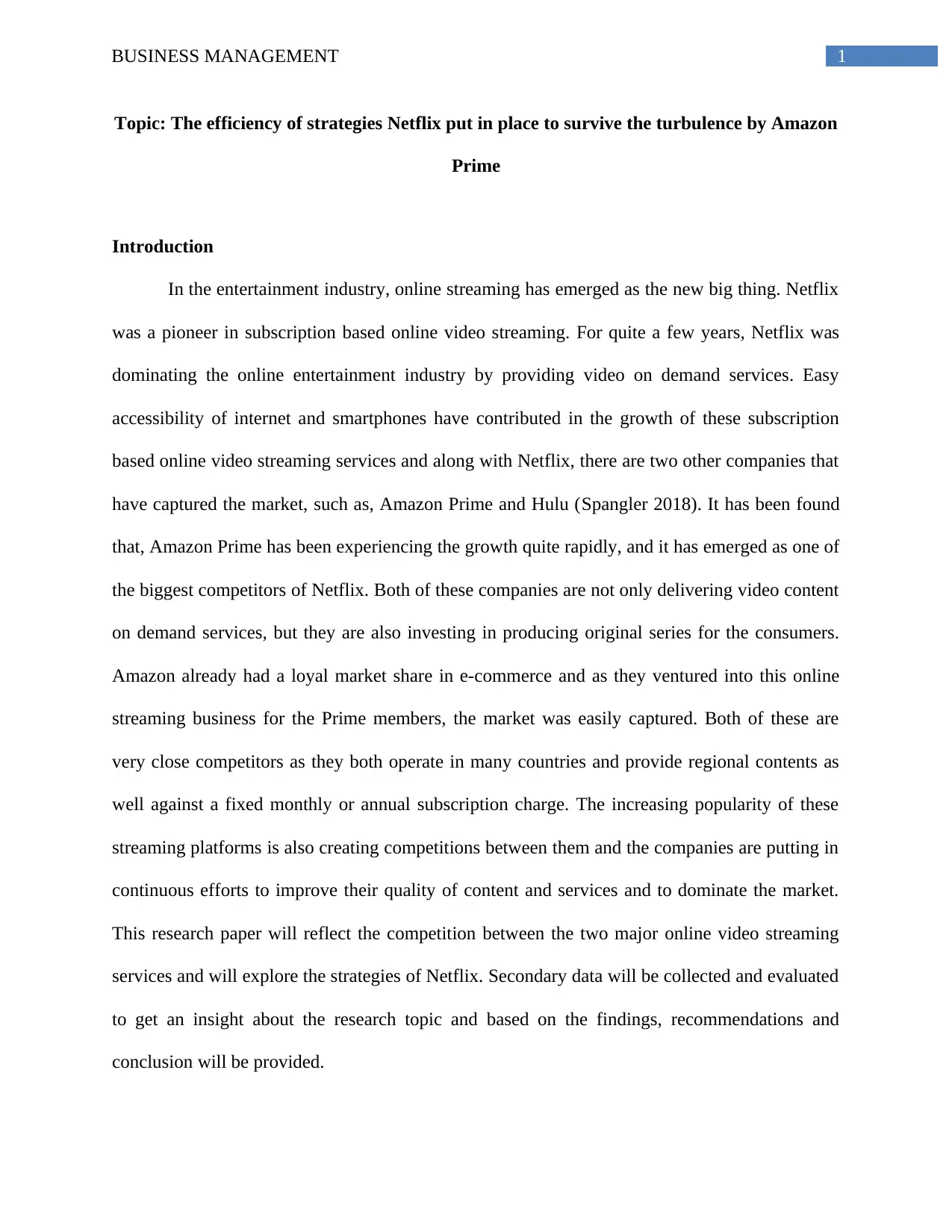
1BUSINESS MANAGEMENT
Topic: The efficiency of strategies Netflix put in place to survive the turbulence by Amazon
Prime
Introduction
In the entertainment industry, online streaming has emerged as the new big thing. Netflix
was a pioneer in subscription based online video streaming. For quite a few years, Netflix was
dominating the online entertainment industry by providing video on demand services. Easy
accessibility of internet and smartphones have contributed in the growth of these subscription
based online video streaming services and along with Netflix, there are two other companies that
have captured the market, such as, Amazon Prime and Hulu (Spangler 2018). It has been found
that, Amazon Prime has been experiencing the growth quite rapidly, and it has emerged as one of
the biggest competitors of Netflix. Both of these companies are not only delivering video content
on demand services, but they are also investing in producing original series for the consumers.
Amazon already had a loyal market share in e-commerce and as they ventured into this online
streaming business for the Prime members, the market was easily captured. Both of these are
very close competitors as they both operate in many countries and provide regional contents as
well against a fixed monthly or annual subscription charge. The increasing popularity of these
streaming platforms is also creating competitions between them and the companies are putting in
continuous efforts to improve their quality of content and services and to dominate the market.
This research paper will reflect the competition between the two major online video streaming
services and will explore the strategies of Netflix. Secondary data will be collected and evaluated
to get an insight about the research topic and based on the findings, recommendations and
conclusion will be provided.
Topic: The efficiency of strategies Netflix put in place to survive the turbulence by Amazon
Prime
Introduction
In the entertainment industry, online streaming has emerged as the new big thing. Netflix
was a pioneer in subscription based online video streaming. For quite a few years, Netflix was
dominating the online entertainment industry by providing video on demand services. Easy
accessibility of internet and smartphones have contributed in the growth of these subscription
based online video streaming services and along with Netflix, there are two other companies that
have captured the market, such as, Amazon Prime and Hulu (Spangler 2018). It has been found
that, Amazon Prime has been experiencing the growth quite rapidly, and it has emerged as one of
the biggest competitors of Netflix. Both of these companies are not only delivering video content
on demand services, but they are also investing in producing original series for the consumers.
Amazon already had a loyal market share in e-commerce and as they ventured into this online
streaming business for the Prime members, the market was easily captured. Both of these are
very close competitors as they both operate in many countries and provide regional contents as
well against a fixed monthly or annual subscription charge. The increasing popularity of these
streaming platforms is also creating competitions between them and the companies are putting in
continuous efforts to improve their quality of content and services and to dominate the market.
This research paper will reflect the competition between the two major online video streaming
services and will explore the strategies of Netflix. Secondary data will be collected and evaluated
to get an insight about the research topic and based on the findings, recommendations and
conclusion will be provided.
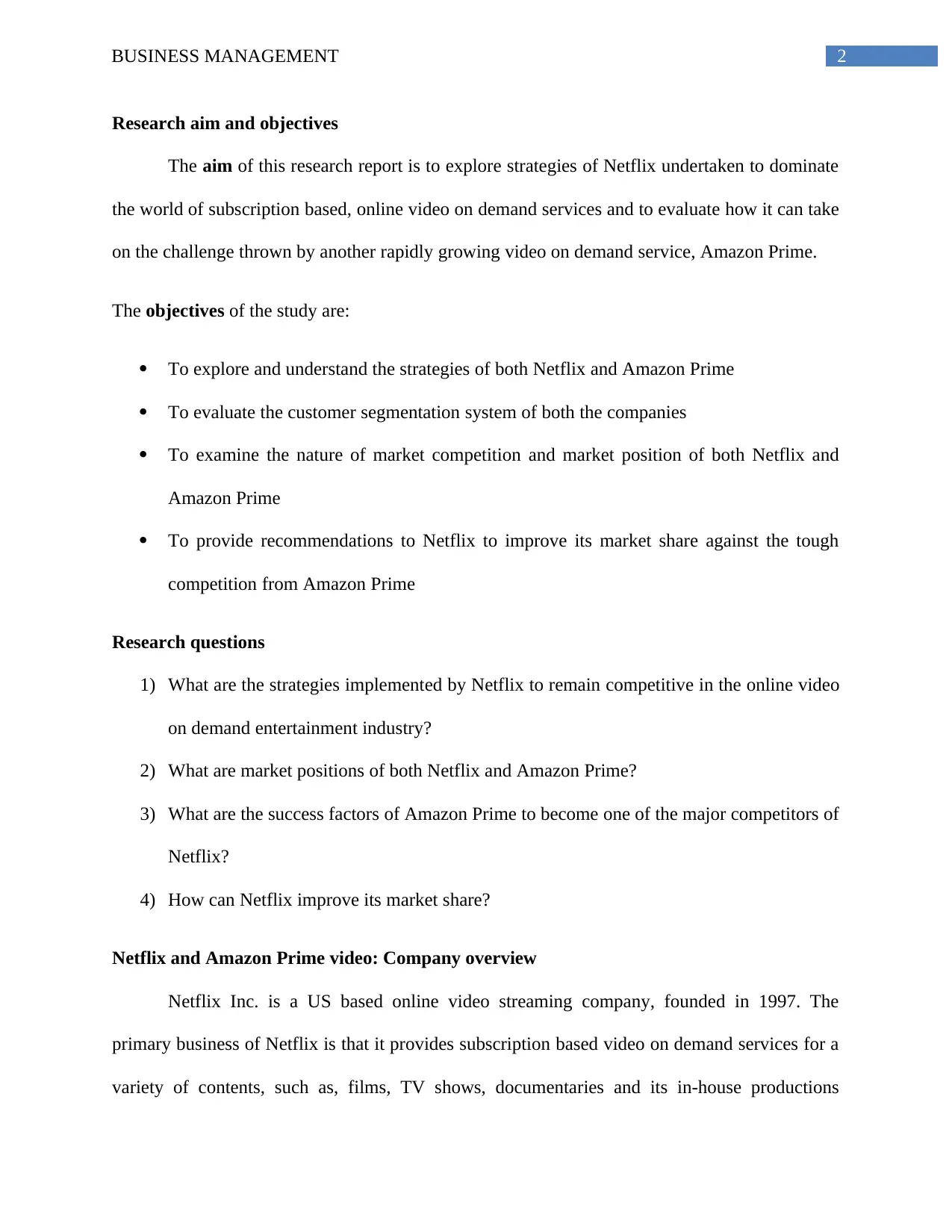
2BUSINESS MANAGEMENT
Research aim and objectives
The aim of this research report is to explore strategies of Netflix undertaken to dominate
the world of subscription based, online video on demand services and to evaluate how it can take
on the challenge thrown by another rapidly growing video on demand service, Amazon Prime.
The objectives of the study are:
To explore and understand the strategies of both Netflix and Amazon Prime
To evaluate the customer segmentation system of both the companies
To examine the nature of market competition and market position of both Netflix and
Amazon Prime
To provide recommendations to Netflix to improve its market share against the tough
competition from Amazon Prime
Research questions
1) What are the strategies implemented by Netflix to remain competitive in the online video
on demand entertainment industry?
2) What are market positions of both Netflix and Amazon Prime?
3) What are the success factors of Amazon Prime to become one of the major competitors of
Netflix?
4) How can Netflix improve its market share?
Netflix and Amazon Prime video: Company overview
Netflix Inc. is a US based online video streaming company, founded in 1997. The
primary business of Netflix is that it provides subscription based video on demand services for a
variety of contents, such as, films, TV shows, documentaries and its in-house productions
Research aim and objectives
The aim of this research report is to explore strategies of Netflix undertaken to dominate
the world of subscription based, online video on demand services and to evaluate how it can take
on the challenge thrown by another rapidly growing video on demand service, Amazon Prime.
The objectives of the study are:
To explore and understand the strategies of both Netflix and Amazon Prime
To evaluate the customer segmentation system of both the companies
To examine the nature of market competition and market position of both Netflix and
Amazon Prime
To provide recommendations to Netflix to improve its market share against the tough
competition from Amazon Prime
Research questions
1) What are the strategies implemented by Netflix to remain competitive in the online video
on demand entertainment industry?
2) What are market positions of both Netflix and Amazon Prime?
3) What are the success factors of Amazon Prime to become one of the major competitors of
Netflix?
4) How can Netflix improve its market share?
Netflix and Amazon Prime video: Company overview
Netflix Inc. is a US based online video streaming company, founded in 1997. The
primary business of Netflix is that it provides subscription based video on demand services for a
variety of contents, such as, films, TV shows, documentaries and its in-house productions
⊘ This is a preview!⊘
Do you want full access?
Subscribe today to unlock all pages.

Trusted by 1+ million students worldwide
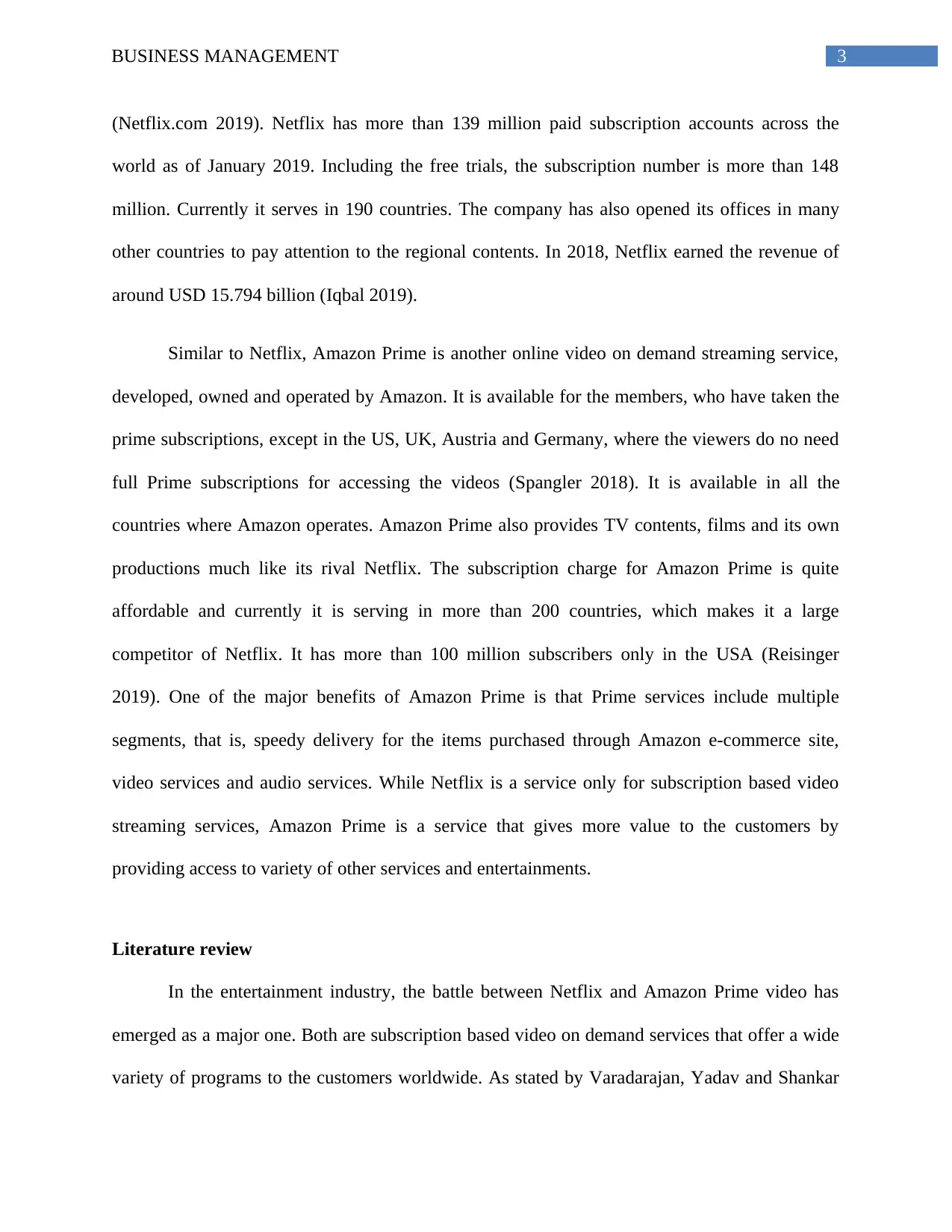
3BUSINESS MANAGEMENT
(Netflix.com 2019). Netflix has more than 139 million paid subscription accounts across the
world as of January 2019. Including the free trials, the subscription number is more than 148
million. Currently it serves in 190 countries. The company has also opened its offices in many
other countries to pay attention to the regional contents. In 2018, Netflix earned the revenue of
around USD 15.794 billion (Iqbal 2019).
Similar to Netflix, Amazon Prime is another online video on demand streaming service,
developed, owned and operated by Amazon. It is available for the members, who have taken the
prime subscriptions, except in the US, UK, Austria and Germany, where the viewers do no need
full Prime subscriptions for accessing the videos (Spangler 2018). It is available in all the
countries where Amazon operates. Amazon Prime also provides TV contents, films and its own
productions much like its rival Netflix. The subscription charge for Amazon Prime is quite
affordable and currently it is serving in more than 200 countries, which makes it a large
competitor of Netflix. It has more than 100 million subscribers only in the USA (Reisinger
2019). One of the major benefits of Amazon Prime is that Prime services include multiple
segments, that is, speedy delivery for the items purchased through Amazon e-commerce site,
video services and audio services. While Netflix is a service only for subscription based video
streaming services, Amazon Prime is a service that gives more value to the customers by
providing access to variety of other services and entertainments.
Literature review
In the entertainment industry, the battle between Netflix and Amazon Prime video has
emerged as a major one. Both are subscription based video on demand services that offer a wide
variety of programs to the customers worldwide. As stated by Varadarajan, Yadav and Shankar
(Netflix.com 2019). Netflix has more than 139 million paid subscription accounts across the
world as of January 2019. Including the free trials, the subscription number is more than 148
million. Currently it serves in 190 countries. The company has also opened its offices in many
other countries to pay attention to the regional contents. In 2018, Netflix earned the revenue of
around USD 15.794 billion (Iqbal 2019).
Similar to Netflix, Amazon Prime is another online video on demand streaming service,
developed, owned and operated by Amazon. It is available for the members, who have taken the
prime subscriptions, except in the US, UK, Austria and Germany, where the viewers do no need
full Prime subscriptions for accessing the videos (Spangler 2018). It is available in all the
countries where Amazon operates. Amazon Prime also provides TV contents, films and its own
productions much like its rival Netflix. The subscription charge for Amazon Prime is quite
affordable and currently it is serving in more than 200 countries, which makes it a large
competitor of Netflix. It has more than 100 million subscribers only in the USA (Reisinger
2019). One of the major benefits of Amazon Prime is that Prime services include multiple
segments, that is, speedy delivery for the items purchased through Amazon e-commerce site,
video services and audio services. While Netflix is a service only for subscription based video
streaming services, Amazon Prime is a service that gives more value to the customers by
providing access to variety of other services and entertainments.
Literature review
In the entertainment industry, the battle between Netflix and Amazon Prime video has
emerged as a major one. Both are subscription based video on demand services that offer a wide
variety of programs to the customers worldwide. As stated by Varadarajan, Yadav and Shankar
Paraphrase This Document
Need a fresh take? Get an instant paraphrase of this document with our AI Paraphraser
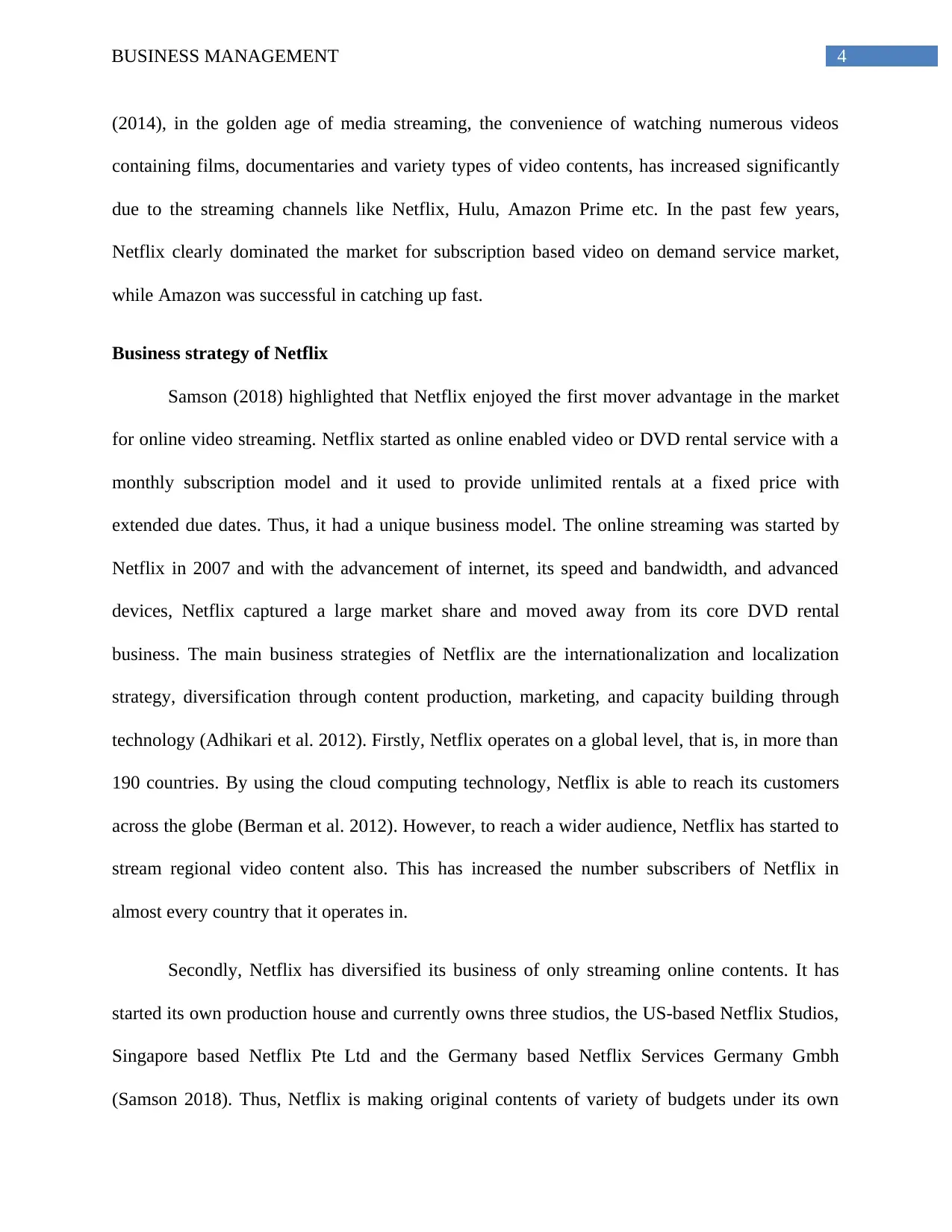
4BUSINESS MANAGEMENT
(2014), in the golden age of media streaming, the convenience of watching numerous videos
containing films, documentaries and variety types of video contents, has increased significantly
due to the streaming channels like Netflix, Hulu, Amazon Prime etc. In the past few years,
Netflix clearly dominated the market for subscription based video on demand service market,
while Amazon was successful in catching up fast.
Business strategy of Netflix
Samson (2018) highlighted that Netflix enjoyed the first mover advantage in the market
for online video streaming. Netflix started as online enabled video or DVD rental service with a
monthly subscription model and it used to provide unlimited rentals at a fixed price with
extended due dates. Thus, it had a unique business model. The online streaming was started by
Netflix in 2007 and with the advancement of internet, its speed and bandwidth, and advanced
devices, Netflix captured a large market share and moved away from its core DVD rental
business. The main business strategies of Netflix are the internationalization and localization
strategy, diversification through content production, marketing, and capacity building through
technology (Adhikari et al. 2012). Firstly, Netflix operates on a global level, that is, in more than
190 countries. By using the cloud computing technology, Netflix is able to reach its customers
across the globe (Berman et al. 2012). However, to reach a wider audience, Netflix has started to
stream regional video content also. This has increased the number subscribers of Netflix in
almost every country that it operates in.
Secondly, Netflix has diversified its business of only streaming online contents. It has
started its own production house and currently owns three studios, the US-based Netflix Studios,
Singapore based Netflix Pte Ltd and the Germany based Netflix Services Germany Gmbh
(Samson 2018). Thus, Netflix is making original contents of variety of budgets under its own
(2014), in the golden age of media streaming, the convenience of watching numerous videos
containing films, documentaries and variety types of video contents, has increased significantly
due to the streaming channels like Netflix, Hulu, Amazon Prime etc. In the past few years,
Netflix clearly dominated the market for subscription based video on demand service market,
while Amazon was successful in catching up fast.
Business strategy of Netflix
Samson (2018) highlighted that Netflix enjoyed the first mover advantage in the market
for online video streaming. Netflix started as online enabled video or DVD rental service with a
monthly subscription model and it used to provide unlimited rentals at a fixed price with
extended due dates. Thus, it had a unique business model. The online streaming was started by
Netflix in 2007 and with the advancement of internet, its speed and bandwidth, and advanced
devices, Netflix captured a large market share and moved away from its core DVD rental
business. The main business strategies of Netflix are the internationalization and localization
strategy, diversification through content production, marketing, and capacity building through
technology (Adhikari et al. 2012). Firstly, Netflix operates on a global level, that is, in more than
190 countries. By using the cloud computing technology, Netflix is able to reach its customers
across the globe (Berman et al. 2012). However, to reach a wider audience, Netflix has started to
stream regional video content also. This has increased the number subscribers of Netflix in
almost every country that it operates in.
Secondly, Netflix has diversified its business of only streaming online contents. It has
started its own production house and currently owns three studios, the US-based Netflix Studios,
Singapore based Netflix Pte Ltd and the Germany based Netflix Services Germany Gmbh
(Samson 2018). Thus, Netflix is making original contents of variety of budgets under its own
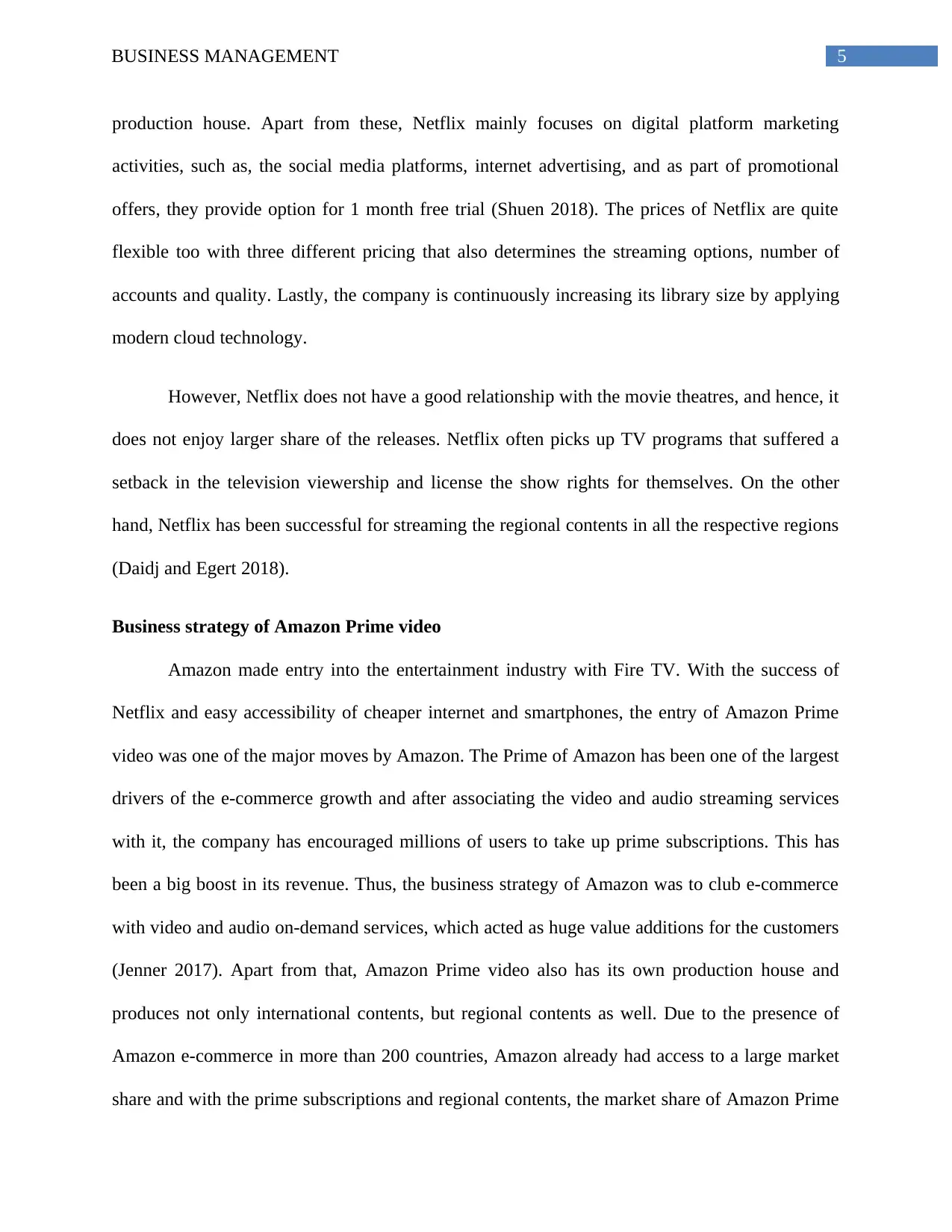
5BUSINESS MANAGEMENT
production house. Apart from these, Netflix mainly focuses on digital platform marketing
activities, such as, the social media platforms, internet advertising, and as part of promotional
offers, they provide option for 1 month free trial (Shuen 2018). The prices of Netflix are quite
flexible too with three different pricing that also determines the streaming options, number of
accounts and quality. Lastly, the company is continuously increasing its library size by applying
modern cloud technology.
However, Netflix does not have a good relationship with the movie theatres, and hence, it
does not enjoy larger share of the releases. Netflix often picks up TV programs that suffered a
setback in the television viewership and license the show rights for themselves. On the other
hand, Netflix has been successful for streaming the regional contents in all the respective regions
(Daidj and Egert 2018).
Business strategy of Amazon Prime video
Amazon made entry into the entertainment industry with Fire TV. With the success of
Netflix and easy accessibility of cheaper internet and smartphones, the entry of Amazon Prime
video was one of the major moves by Amazon. The Prime of Amazon has been one of the largest
drivers of the e-commerce growth and after associating the video and audio streaming services
with it, the company has encouraged millions of users to take up prime subscriptions. This has
been a big boost in its revenue. Thus, the business strategy of Amazon was to club e-commerce
with video and audio on-demand services, which acted as huge value additions for the customers
(Jenner 2017). Apart from that, Amazon Prime video also has its own production house and
produces not only international contents, but regional contents as well. Due to the presence of
Amazon e-commerce in more than 200 countries, Amazon already had access to a large market
share and with the prime subscriptions and regional contents, the market share of Amazon Prime
production house. Apart from these, Netflix mainly focuses on digital platform marketing
activities, such as, the social media platforms, internet advertising, and as part of promotional
offers, they provide option for 1 month free trial (Shuen 2018). The prices of Netflix are quite
flexible too with three different pricing that also determines the streaming options, number of
accounts and quality. Lastly, the company is continuously increasing its library size by applying
modern cloud technology.
However, Netflix does not have a good relationship with the movie theatres, and hence, it
does not enjoy larger share of the releases. Netflix often picks up TV programs that suffered a
setback in the television viewership and license the show rights for themselves. On the other
hand, Netflix has been successful for streaming the regional contents in all the respective regions
(Daidj and Egert 2018).
Business strategy of Amazon Prime video
Amazon made entry into the entertainment industry with Fire TV. With the success of
Netflix and easy accessibility of cheaper internet and smartphones, the entry of Amazon Prime
video was one of the major moves by Amazon. The Prime of Amazon has been one of the largest
drivers of the e-commerce growth and after associating the video and audio streaming services
with it, the company has encouraged millions of users to take up prime subscriptions. This has
been a big boost in its revenue. Thus, the business strategy of Amazon was to club e-commerce
with video and audio on-demand services, which acted as huge value additions for the customers
(Jenner 2017). Apart from that, Amazon Prime video also has its own production house and
produces not only international contents, but regional contents as well. Due to the presence of
Amazon e-commerce in more than 200 countries, Amazon already had access to a large market
share and with the prime subscriptions and regional contents, the market share of Amazon Prime
⊘ This is a preview!⊘
Do you want full access?
Subscribe today to unlock all pages.

Trusted by 1+ million students worldwide
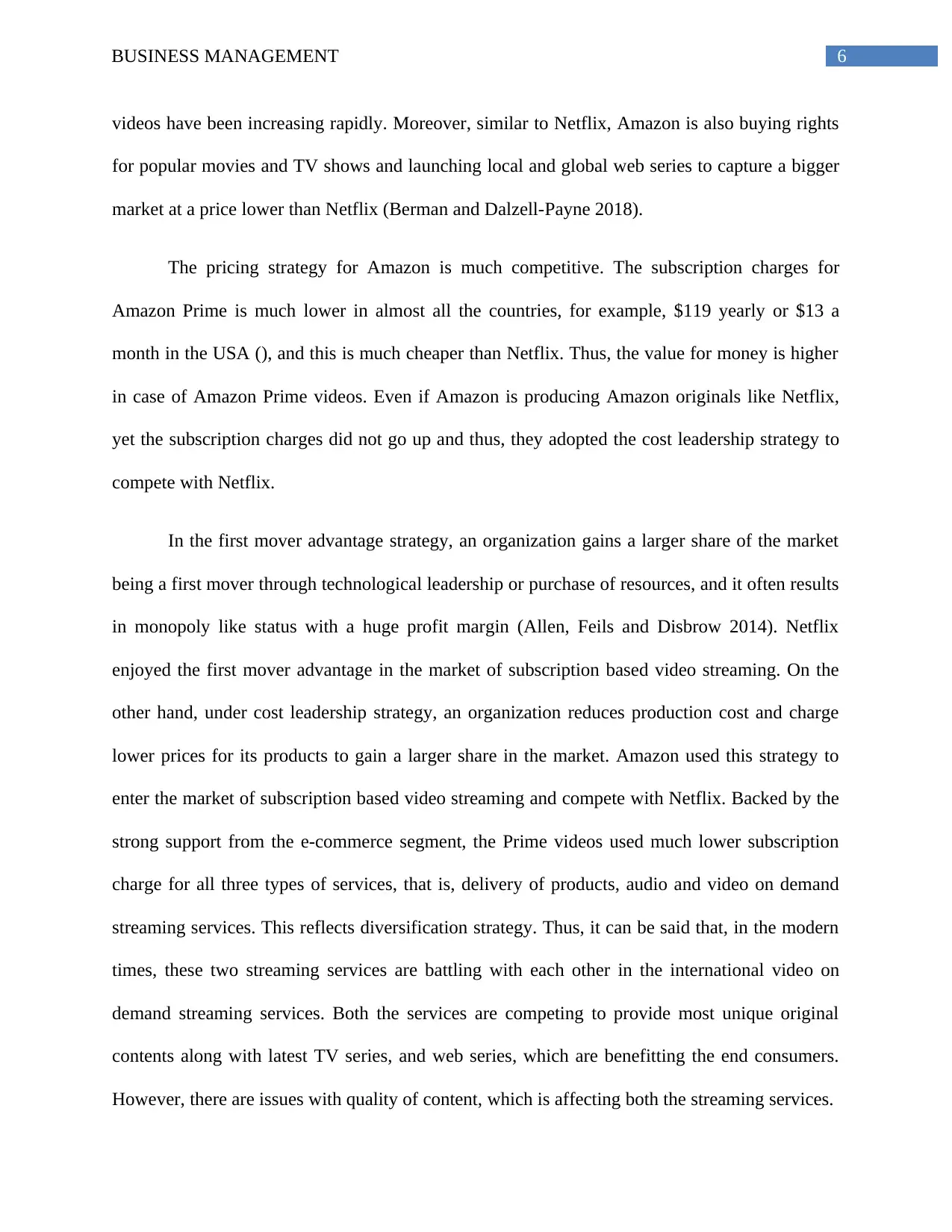
6BUSINESS MANAGEMENT
videos have been increasing rapidly. Moreover, similar to Netflix, Amazon is also buying rights
for popular movies and TV shows and launching local and global web series to capture a bigger
market at a price lower than Netflix (Berman and Dalzell-Payne 2018).
The pricing strategy for Amazon is much competitive. The subscription charges for
Amazon Prime is much lower in almost all the countries, for example, $119 yearly or $13 a
month in the USA (), and this is much cheaper than Netflix. Thus, the value for money is higher
in case of Amazon Prime videos. Even if Amazon is producing Amazon originals like Netflix,
yet the subscription charges did not go up and thus, they adopted the cost leadership strategy to
compete with Netflix.
In the first mover advantage strategy, an organization gains a larger share of the market
being a first mover through technological leadership or purchase of resources, and it often results
in monopoly like status with a huge profit margin (Allen, Feils and Disbrow 2014). Netflix
enjoyed the first mover advantage in the market of subscription based video streaming. On the
other hand, under cost leadership strategy, an organization reduces production cost and charge
lower prices for its products to gain a larger share in the market. Amazon used this strategy to
enter the market of subscription based video streaming and compete with Netflix. Backed by the
strong support from the e-commerce segment, the Prime videos used much lower subscription
charge for all three types of services, that is, delivery of products, audio and video on demand
streaming services. This reflects diversification strategy. Thus, it can be said that, in the modern
times, these two streaming services are battling with each other in the international video on
demand streaming services. Both the services are competing to provide most unique original
contents along with latest TV series, and web series, which are benefitting the end consumers.
However, there are issues with quality of content, which is affecting both the streaming services.
videos have been increasing rapidly. Moreover, similar to Netflix, Amazon is also buying rights
for popular movies and TV shows and launching local and global web series to capture a bigger
market at a price lower than Netflix (Berman and Dalzell-Payne 2018).
The pricing strategy for Amazon is much competitive. The subscription charges for
Amazon Prime is much lower in almost all the countries, for example, $119 yearly or $13 a
month in the USA (), and this is much cheaper than Netflix. Thus, the value for money is higher
in case of Amazon Prime videos. Even if Amazon is producing Amazon originals like Netflix,
yet the subscription charges did not go up and thus, they adopted the cost leadership strategy to
compete with Netflix.
In the first mover advantage strategy, an organization gains a larger share of the market
being a first mover through technological leadership or purchase of resources, and it often results
in monopoly like status with a huge profit margin (Allen, Feils and Disbrow 2014). Netflix
enjoyed the first mover advantage in the market of subscription based video streaming. On the
other hand, under cost leadership strategy, an organization reduces production cost and charge
lower prices for its products to gain a larger share in the market. Amazon used this strategy to
enter the market of subscription based video streaming and compete with Netflix. Backed by the
strong support from the e-commerce segment, the Prime videos used much lower subscription
charge for all three types of services, that is, delivery of products, audio and video on demand
streaming services. This reflects diversification strategy. Thus, it can be said that, in the modern
times, these two streaming services are battling with each other in the international video on
demand streaming services. Both the services are competing to provide most unique original
contents along with latest TV series, and web series, which are benefitting the end consumers.
However, there are issues with quality of content, which is affecting both the streaming services.
Paraphrase This Document
Need a fresh take? Get an instant paraphrase of this document with our AI Paraphraser
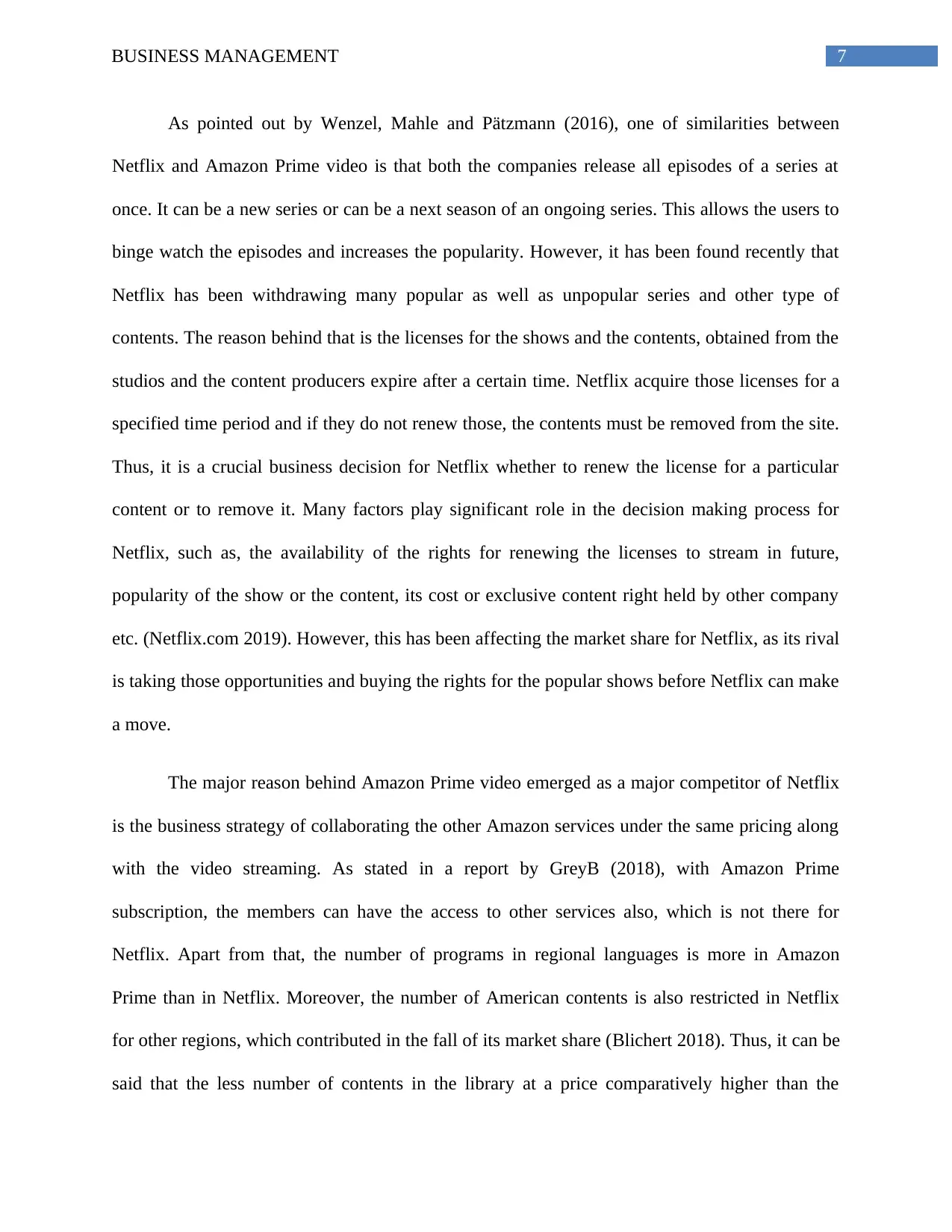
7BUSINESS MANAGEMENT
As pointed out by Wenzel, Mahle and Pätzmann (2016), one of similarities between
Netflix and Amazon Prime video is that both the companies release all episodes of a series at
once. It can be a new series or can be a next season of an ongoing series. This allows the users to
binge watch the episodes and increases the popularity. However, it has been found recently that
Netflix has been withdrawing many popular as well as unpopular series and other type of
contents. The reason behind that is the licenses for the shows and the contents, obtained from the
studios and the content producers expire after a certain time. Netflix acquire those licenses for a
specified time period and if they do not renew those, the contents must be removed from the site.
Thus, it is a crucial business decision for Netflix whether to renew the license for a particular
content or to remove it. Many factors play significant role in the decision making process for
Netflix, such as, the availability of the rights for renewing the licenses to stream in future,
popularity of the show or the content, its cost or exclusive content right held by other company
etc. (Netflix.com 2019). However, this has been affecting the market share for Netflix, as its rival
is taking those opportunities and buying the rights for the popular shows before Netflix can make
a move.
The major reason behind Amazon Prime video emerged as a major competitor of Netflix
is the business strategy of collaborating the other Amazon services under the same pricing along
with the video streaming. As stated in a report by GreyB (2018), with Amazon Prime
subscription, the members can have the access to other services also, which is not there for
Netflix. Apart from that, the number of programs in regional languages is more in Amazon
Prime than in Netflix. Moreover, the number of American contents is also restricted in Netflix
for other regions, which contributed in the fall of its market share (Blichert 2018). Thus, it can be
said that the less number of contents in the library at a price comparatively higher than the
As pointed out by Wenzel, Mahle and Pätzmann (2016), one of similarities between
Netflix and Amazon Prime video is that both the companies release all episodes of a series at
once. It can be a new series or can be a next season of an ongoing series. This allows the users to
binge watch the episodes and increases the popularity. However, it has been found recently that
Netflix has been withdrawing many popular as well as unpopular series and other type of
contents. The reason behind that is the licenses for the shows and the contents, obtained from the
studios and the content producers expire after a certain time. Netflix acquire those licenses for a
specified time period and if they do not renew those, the contents must be removed from the site.
Thus, it is a crucial business decision for Netflix whether to renew the license for a particular
content or to remove it. Many factors play significant role in the decision making process for
Netflix, such as, the availability of the rights for renewing the licenses to stream in future,
popularity of the show or the content, its cost or exclusive content right held by other company
etc. (Netflix.com 2019). However, this has been affecting the market share for Netflix, as its rival
is taking those opportunities and buying the rights for the popular shows before Netflix can make
a move.
The major reason behind Amazon Prime video emerged as a major competitor of Netflix
is the business strategy of collaborating the other Amazon services under the same pricing along
with the video streaming. As stated in a report by GreyB (2018), with Amazon Prime
subscription, the members can have the access to other services also, which is not there for
Netflix. Apart from that, the number of programs in regional languages is more in Amazon
Prime than in Netflix. Moreover, the number of American contents is also restricted in Netflix
for other regions, which contributed in the fall of its market share (Blichert 2018). Thus, it can be
said that the less number of contents in the library at a price comparatively higher than the
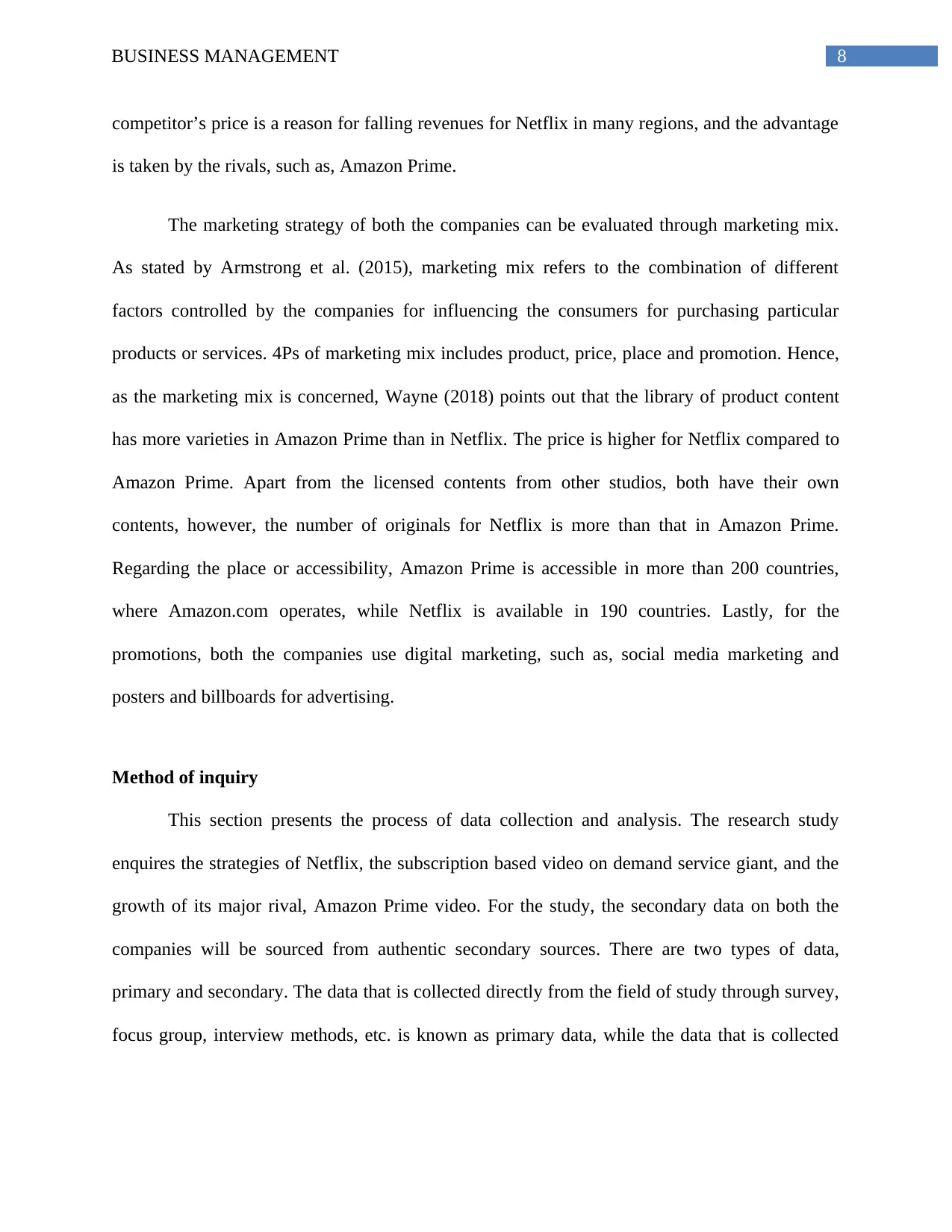
8BUSINESS MANAGEMENT
competitor’s price is a reason for falling revenues for Netflix in many regions, and the advantage
is taken by the rivals, such as, Amazon Prime.
The marketing strategy of both the companies can be evaluated through marketing mix.
As stated by Armstrong et al. (2015), marketing mix refers to the combination of different
factors controlled by the companies for influencing the consumers for purchasing particular
products or services. 4Ps of marketing mix includes product, price, place and promotion. Hence,
as the marketing mix is concerned, Wayne (2018) points out that the library of product content
has more varieties in Amazon Prime than in Netflix. The price is higher for Netflix compared to
Amazon Prime. Apart from the licensed contents from other studios, both have their own
contents, however, the number of originals for Netflix is more than that in Amazon Prime.
Regarding the place or accessibility, Amazon Prime is accessible in more than 200 countries,
where Amazon.com operates, while Netflix is available in 190 countries. Lastly, for the
promotions, both the companies use digital marketing, such as, social media marketing and
posters and billboards for advertising.
Method of inquiry
This section presents the process of data collection and analysis. The research study
enquires the strategies of Netflix, the subscription based video on demand service giant, and the
growth of its major rival, Amazon Prime video. For the study, the secondary data on both the
companies will be sourced from authentic secondary sources. There are two types of data,
primary and secondary. The data that is collected directly from the field of study through survey,
focus group, interview methods, etc. is known as primary data, while the data that is collected
competitor’s price is a reason for falling revenues for Netflix in many regions, and the advantage
is taken by the rivals, such as, Amazon Prime.
The marketing strategy of both the companies can be evaluated through marketing mix.
As stated by Armstrong et al. (2015), marketing mix refers to the combination of different
factors controlled by the companies for influencing the consumers for purchasing particular
products or services. 4Ps of marketing mix includes product, price, place and promotion. Hence,
as the marketing mix is concerned, Wayne (2018) points out that the library of product content
has more varieties in Amazon Prime than in Netflix. The price is higher for Netflix compared to
Amazon Prime. Apart from the licensed contents from other studios, both have their own
contents, however, the number of originals for Netflix is more than that in Amazon Prime.
Regarding the place or accessibility, Amazon Prime is accessible in more than 200 countries,
where Amazon.com operates, while Netflix is available in 190 countries. Lastly, for the
promotions, both the companies use digital marketing, such as, social media marketing and
posters and billboards for advertising.
Method of inquiry
This section presents the process of data collection and analysis. The research study
enquires the strategies of Netflix, the subscription based video on demand service giant, and the
growth of its major rival, Amazon Prime video. For the study, the secondary data on both the
companies will be sourced from authentic secondary sources. There are two types of data,
primary and secondary. The data that is collected directly from the field of study through survey,
focus group, interview methods, etc. is known as primary data, while the data that is collected
⊘ This is a preview!⊘
Do you want full access?
Subscribe today to unlock all pages.

Trusted by 1+ million students worldwide
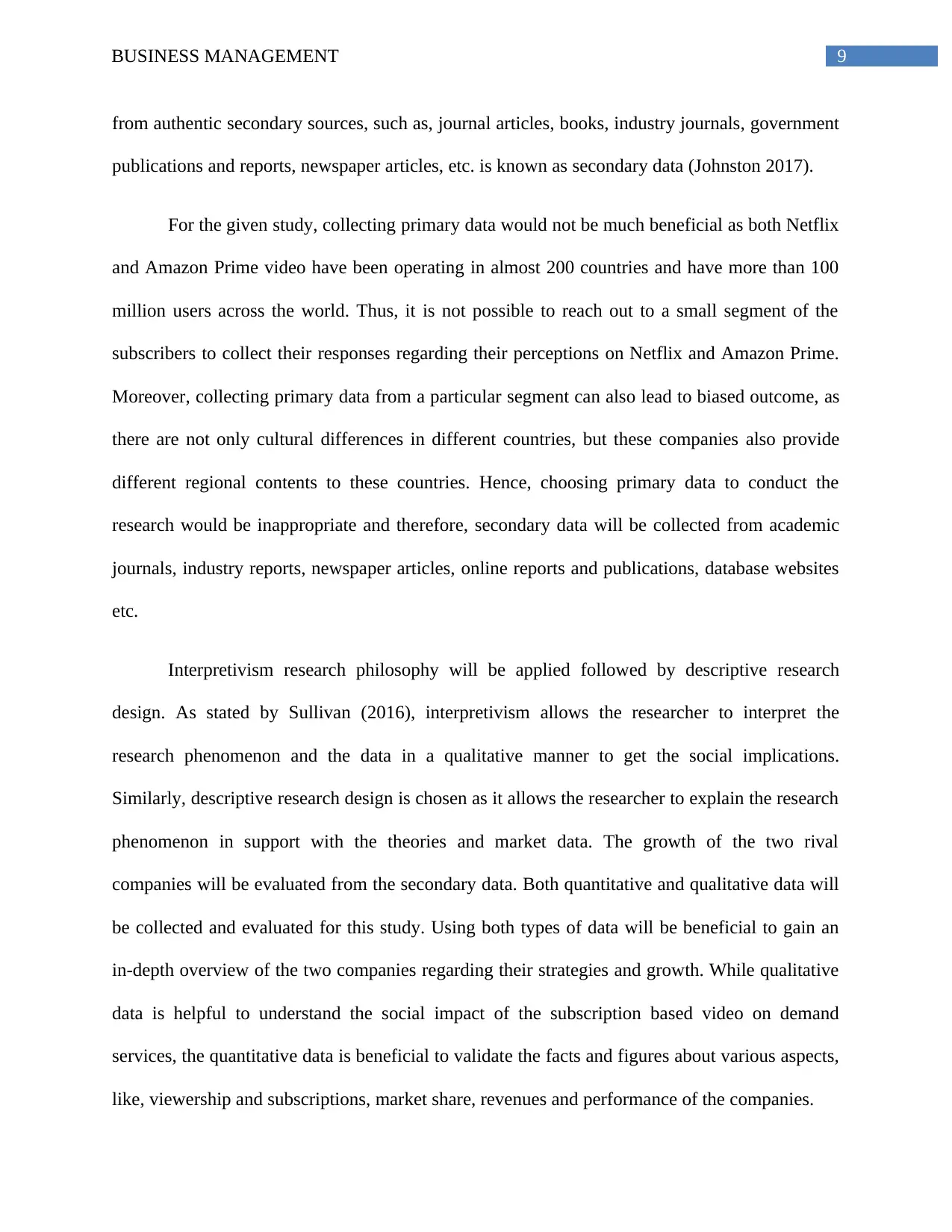
9BUSINESS MANAGEMENT
from authentic secondary sources, such as, journal articles, books, industry journals, government
publications and reports, newspaper articles, etc. is known as secondary data (Johnston 2017).
For the given study, collecting primary data would not be much beneficial as both Netflix
and Amazon Prime video have been operating in almost 200 countries and have more than 100
million users across the world. Thus, it is not possible to reach out to a small segment of the
subscribers to collect their responses regarding their perceptions on Netflix and Amazon Prime.
Moreover, collecting primary data from a particular segment can also lead to biased outcome, as
there are not only cultural differences in different countries, but these companies also provide
different regional contents to these countries. Hence, choosing primary data to conduct the
research would be inappropriate and therefore, secondary data will be collected from academic
journals, industry reports, newspaper articles, online reports and publications, database websites
etc.
Interpretivism research philosophy will be applied followed by descriptive research
design. As stated by Sullivan (2016), interpretivism allows the researcher to interpret the
research phenomenon and the data in a qualitative manner to get the social implications.
Similarly, descriptive research design is chosen as it allows the researcher to explain the research
phenomenon in support with the theories and market data. The growth of the two rival
companies will be evaluated from the secondary data. Both quantitative and qualitative data will
be collected and evaluated for this study. Using both types of data will be beneficial to gain an
in-depth overview of the two companies regarding their strategies and growth. While qualitative
data is helpful to understand the social impact of the subscription based video on demand
services, the quantitative data is beneficial to validate the facts and figures about various aspects,
like, viewership and subscriptions, market share, revenues and performance of the companies.
from authentic secondary sources, such as, journal articles, books, industry journals, government
publications and reports, newspaper articles, etc. is known as secondary data (Johnston 2017).
For the given study, collecting primary data would not be much beneficial as both Netflix
and Amazon Prime video have been operating in almost 200 countries and have more than 100
million users across the world. Thus, it is not possible to reach out to a small segment of the
subscribers to collect their responses regarding their perceptions on Netflix and Amazon Prime.
Moreover, collecting primary data from a particular segment can also lead to biased outcome, as
there are not only cultural differences in different countries, but these companies also provide
different regional contents to these countries. Hence, choosing primary data to conduct the
research would be inappropriate and therefore, secondary data will be collected from academic
journals, industry reports, newspaper articles, online reports and publications, database websites
etc.
Interpretivism research philosophy will be applied followed by descriptive research
design. As stated by Sullivan (2016), interpretivism allows the researcher to interpret the
research phenomenon and the data in a qualitative manner to get the social implications.
Similarly, descriptive research design is chosen as it allows the researcher to explain the research
phenomenon in support with the theories and market data. The growth of the two rival
companies will be evaluated from the secondary data. Both quantitative and qualitative data will
be collected and evaluated for this study. Using both types of data will be beneficial to gain an
in-depth overview of the two companies regarding their strategies and growth. While qualitative
data is helpful to understand the social impact of the subscription based video on demand
services, the quantitative data is beneficial to validate the facts and figures about various aspects,
like, viewership and subscriptions, market share, revenues and performance of the companies.
Paraphrase This Document
Need a fresh take? Get an instant paraphrase of this document with our AI Paraphraser

10BUSINESS MANAGEMENT
Timeline
Week
Task 1 2 3 4 5 6 7 8 9 10 11 12
Research strategy formulation
Framework design
Literature review
Secondary data collection
Data analysis
Presentation of the findings and
discussion
Conclusion and
recommendation
Report submission
(Created by author)
The entire project will be conducted within 12 weeks. As seen from the time schedule above, the
first 2 weeks will be required to make the research strategy and framework for the study, such as,
selecting the research strategy and making the plans to collect and analyze the data. From 2nd to
4th week, an extensive literature review will be conducted to gain knowledge about the research
subject and create the context of the study. Since the project will be entirely based on the
secondary data, after the literature review is done, the secondary data will be collected from 5th to
7th week. The analysis will be conducted 8th week onwards for three weeks. The presentation of
findings and discussion will be conducted on 10th and 11th week and the recommendation and
conclusion will be presented in the 11th and 12th week. Lastly, the project will be submitted on
the 12th week.
Timeline
Week
Task 1 2 3 4 5 6 7 8 9 10 11 12
Research strategy formulation
Framework design
Literature review
Secondary data collection
Data analysis
Presentation of the findings and
discussion
Conclusion and
recommendation
Report submission
(Created by author)
The entire project will be conducted within 12 weeks. As seen from the time schedule above, the
first 2 weeks will be required to make the research strategy and framework for the study, such as,
selecting the research strategy and making the plans to collect and analyze the data. From 2nd to
4th week, an extensive literature review will be conducted to gain knowledge about the research
subject and create the context of the study. Since the project will be entirely based on the
secondary data, after the literature review is done, the secondary data will be collected from 5th to
7th week. The analysis will be conducted 8th week onwards for three weeks. The presentation of
findings and discussion will be conducted on 10th and 11th week and the recommendation and
conclusion will be presented in the 11th and 12th week. Lastly, the project will be submitted on
the 12th week.
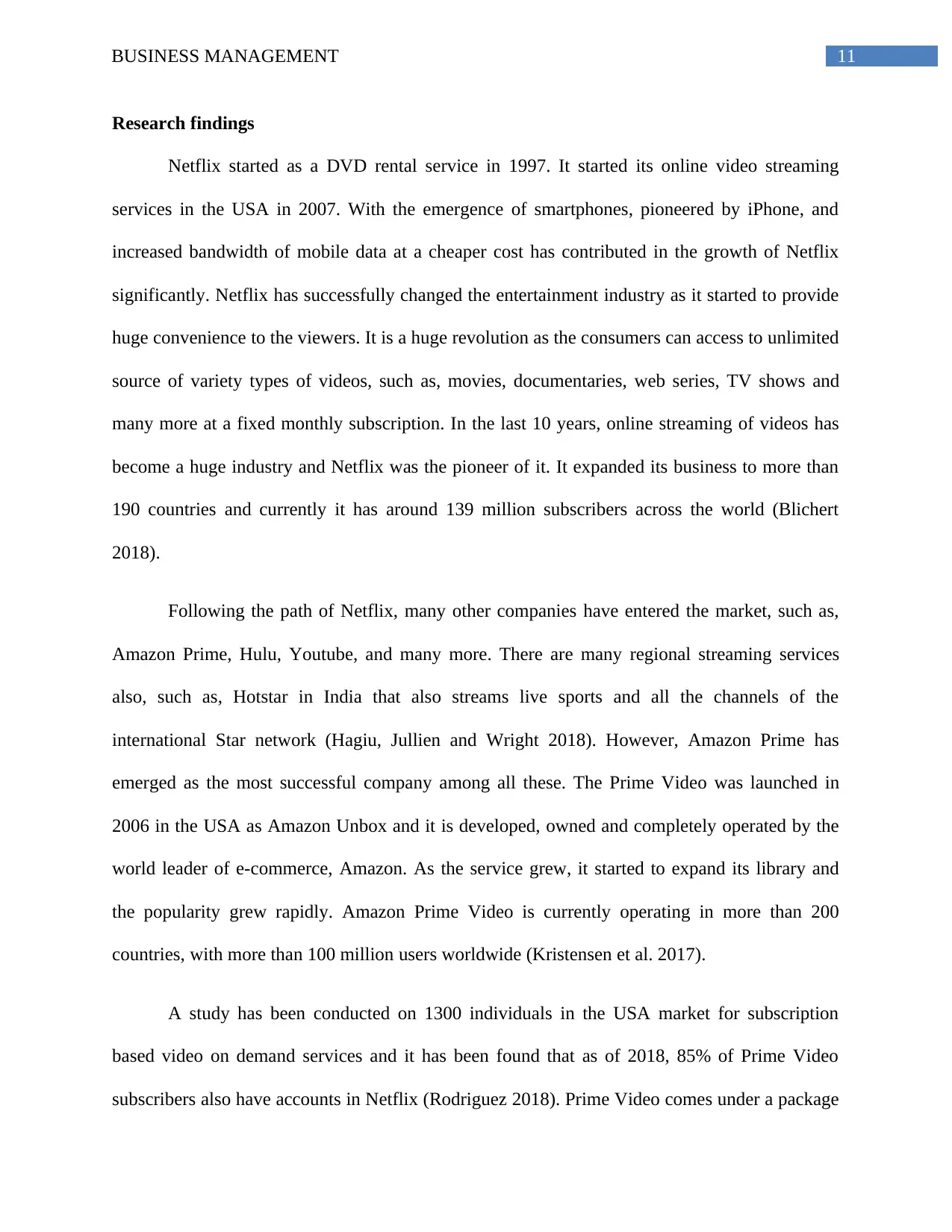
11BUSINESS MANAGEMENT
Research findings
Netflix started as a DVD rental service in 1997. It started its online video streaming
services in the USA in 2007. With the emergence of smartphones, pioneered by iPhone, and
increased bandwidth of mobile data at a cheaper cost has contributed in the growth of Netflix
significantly. Netflix has successfully changed the entertainment industry as it started to provide
huge convenience to the viewers. It is a huge revolution as the consumers can access to unlimited
source of variety types of videos, such as, movies, documentaries, web series, TV shows and
many more at a fixed monthly subscription. In the last 10 years, online streaming of videos has
become a huge industry and Netflix was the pioneer of it. It expanded its business to more than
190 countries and currently it has around 139 million subscribers across the world (Blichert
2018).
Following the path of Netflix, many other companies have entered the market, such as,
Amazon Prime, Hulu, Youtube, and many more. There are many regional streaming services
also, such as, Hotstar in India that also streams live sports and all the channels of the
international Star network (Hagiu, Jullien and Wright 2018). However, Amazon Prime has
emerged as the most successful company among all these. The Prime Video was launched in
2006 in the USA as Amazon Unbox and it is developed, owned and completely operated by the
world leader of e-commerce, Amazon. As the service grew, it started to expand its library and
the popularity grew rapidly. Amazon Prime Video is currently operating in more than 200
countries, with more than 100 million users worldwide (Kristensen et al. 2017).
A study has been conducted on 1300 individuals in the USA market for subscription
based video on demand services and it has been found that as of 2018, 85% of Prime Video
subscribers also have accounts in Netflix (Rodriguez 2018). Prime Video comes under a package
Research findings
Netflix started as a DVD rental service in 1997. It started its online video streaming
services in the USA in 2007. With the emergence of smartphones, pioneered by iPhone, and
increased bandwidth of mobile data at a cheaper cost has contributed in the growth of Netflix
significantly. Netflix has successfully changed the entertainment industry as it started to provide
huge convenience to the viewers. It is a huge revolution as the consumers can access to unlimited
source of variety types of videos, such as, movies, documentaries, web series, TV shows and
many more at a fixed monthly subscription. In the last 10 years, online streaming of videos has
become a huge industry and Netflix was the pioneer of it. It expanded its business to more than
190 countries and currently it has around 139 million subscribers across the world (Blichert
2018).
Following the path of Netflix, many other companies have entered the market, such as,
Amazon Prime, Hulu, Youtube, and many more. There are many regional streaming services
also, such as, Hotstar in India that also streams live sports and all the channels of the
international Star network (Hagiu, Jullien and Wright 2018). However, Amazon Prime has
emerged as the most successful company among all these. The Prime Video was launched in
2006 in the USA as Amazon Unbox and it is developed, owned and completely operated by the
world leader of e-commerce, Amazon. As the service grew, it started to expand its library and
the popularity grew rapidly. Amazon Prime Video is currently operating in more than 200
countries, with more than 100 million users worldwide (Kristensen et al. 2017).
A study has been conducted on 1300 individuals in the USA market for subscription
based video on demand services and it has been found that as of 2018, 85% of Prime Video
subscribers also have accounts in Netflix (Rodriguez 2018). Prime Video comes under a package
⊘ This is a preview!⊘
Do you want full access?
Subscribe today to unlock all pages.

Trusted by 1+ million students worldwide
1 out of 26
Related Documents
Your All-in-One AI-Powered Toolkit for Academic Success.
+13062052269
info@desklib.com
Available 24*7 on WhatsApp / Email
![[object Object]](/_next/static/media/star-bottom.7253800d.svg)
Unlock your academic potential
Copyright © 2020–2025 A2Z Services. All Rights Reserved. Developed and managed by ZUCOL.





